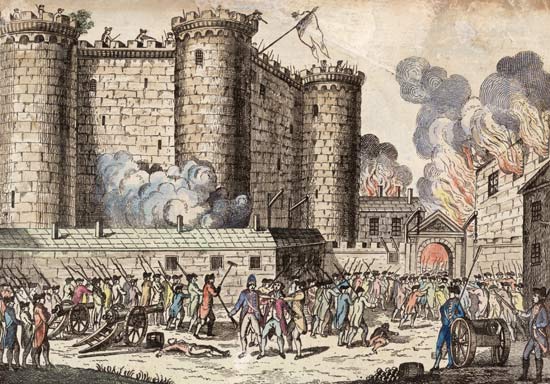[From www.altiusdirectory.com]

France celebrates Bastille Day as a national holiday on July 14 every year which was known as Fete Nationale or le quatorze juillet. Bastille Day is celebrated to commemorate the Storming of the Bastille on July 14, 1789. Storming of the Bastille, a fortress-prison which housed many political prisoners, arms and ammunition, symbolized uprising by the oppressed people in France and end of Monarchy in the country.
History of the Bastille Day
Oppressed by the rule of Louis XVI, people of Paris stormed Bastille to challenge the absolute rule of monarchy in the country and to get hold of arms and ammunition to protect the general public. Bastille, which was known to house many prisoners who had displeased the royalty, had only seven inmates when people attacked it. Seeing a huge turnout of mob outside the fort, Bastille’s commander Governor de Launay surrendered. However, fighting resumed due to some misunderstanding. Around 108 people, mostly attackers, were killed in the fighting.
The storming of the Bastille led to abolition of feudalism on August 4 and proclamation of the Declaration of the Rights of Man and of the Citizen. On the first anniversary of the storming of the Bastille Day, the Fete de la Federation was held on Champ de Mars where a mass was organized and King Louis XVI along with his confidant General Lafayette took oath to the Constitution. A four-day feast was also organized and fireworks display dazzled the people with its sheer extravagance.
Celebrations of the Bastille Day
The celebration of Bastille Day was proposed by Benjamin Raspail on May 21, 1880, who proposed a law to celebrate July 14 as a national holiday everywhere. Assembly and Senate passed the bill and it was on July 6, 1880, that the law became official. The first official celebration of Bastille Day as a national holiday on July 14 was magnificent.
France President presides over the Bastille Day celebrations held at Champs Elysees Avenue in Paris on July 14 in the morning. Cadets from different military contingents followed by motorized troops and aviation troops are the highlights of the parade. France follows a tradition wherein it invites troops of Allied forces. President addresses media on the recent events and future projects and holds a party at Palais de l’Elysee. France’s Constitution empowers the President to pardon offenders. President has been pardoning some offenders since 1991. However, President Nicholas Sarkozy put an end to this practice in 2007. In 1979, a Guinness World record was made on the day for the largest outdoor gathering at a concert by Jean Michel Jarre on Place de la Concorde in Paris.
*
[From www.flickr.com]
Josephe Jeanne Marie Antoinette von Habsburg-Lorraine, aka Marie Antoinette, Queen of France (November 2, 1755 – October 16, 1793) It may be that the champagne glass so familiar today was modeled upon the famous breast of Marie Antoinette, and that her most famed and inflaming quote "Let them eat cake," is fabricated political propoganda, but hindsight renders much of what was so scandalous in her own day, down right trivial by our own standards. From sycophantic tyrantess, to an obsolete, fluffy-headed haute grandeur, to doomed teen queen, Marie Antoinette's image has been somewhat resurrected in recent years. The truth, in the early years, lies somewhere inbetween this laundry list of feminine archetypes. But it was towards the end, when most of us grow up (she was 37 when she was executed), that her spirit and fortitude shone most. In the end, all pomp gone, she was a dedicated mother, sister, and wife. Brave as a tigress and willing to sacrifice all for her family, this is the picture that is rarely shown in our history books, literature and cinema. Bastille was a fortress and state prison in Paris, located, until its demolition (started in 1789), near the site of the present Place de la Bastille. Arbitrary and secret imprisonment by lettre de cachet gave rise to stories of horror, but actually the Bastille was generally used for persons of influence, and its regime for most political prisoners was mild. On July 14, 1789, a Parisian crowd stormed the Bastille in the hope of capturing ammunition. The governor was killed; the seven inmates, none of them political prisoners, were freed. The storming of the Bastille marks the beginning of the French Revolution, and July 14–Bastille Day–became the national holiday of republican France.
From the fall of the Bastille, July 14th, 1789, til the day of her execution on October 16, 1793, her life became a series of ever shrinking spaces. In 1790 the royal family was taken by force from the palace of Versaille fifteen miles outside of Paris, to a carefully guarded Tuileries Palace in Paris. After a failed attempt to escape in disguise in 1791 to Austria (they were captured in Varenne), rather than bend and except a Republican Monarchy, Marie Antoinette machinated a war with Austria (her home country) that she'd hoped France would lose, and the family would be rescued. The parisienne masses were incensed at such gall, and on August 10, 1792 the mob stormed the Tuileries and massacred the Swiss Guard, while the royal family fled. A few days later Louis XVI was arrested and on September 21 1792 the monarchy in France was officially abolished. The family was moved to the Temple Fortress and put under heavy guard. The Princesse de Lamballe, who up until this point had shared the fate of her closest friend, was seperated from Marie Antoinette and forced to repudiate her. When she refused she was attacked by the mob and beaten to death with a hammer. The story goes that she was torn apart, her head paraded on a pike in front of the Queen's prison window, but the story cannot be substantiated beyond hear say.





